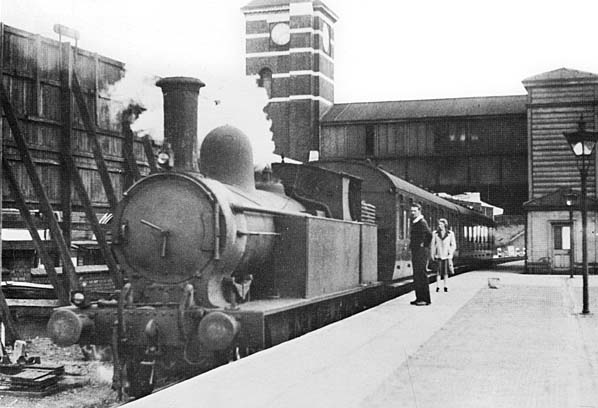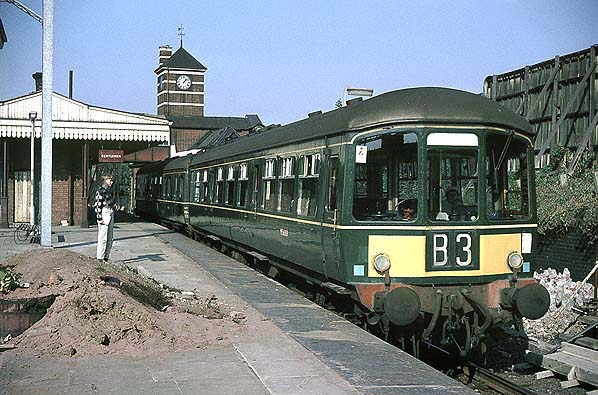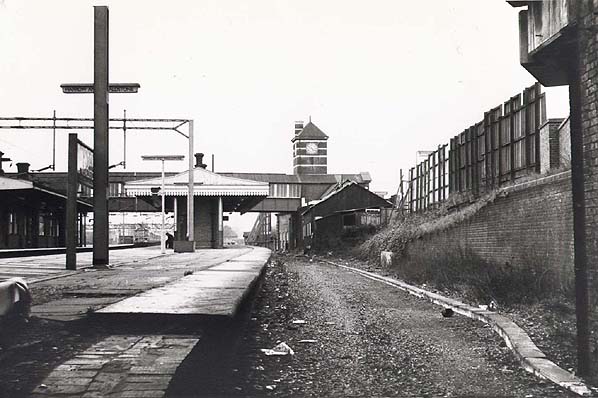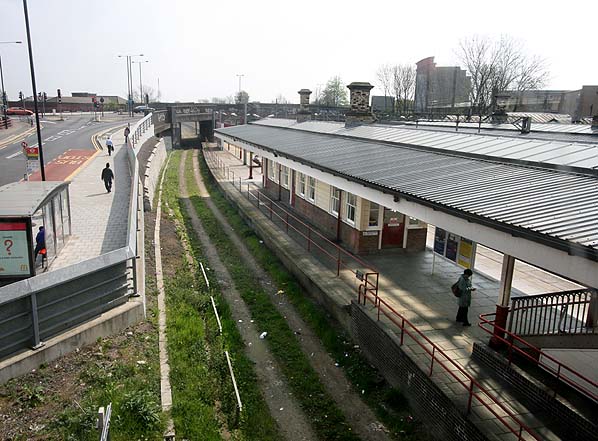
Station Name: HARROW & WEALDSTONE
|
| Date opened: | 20.7.1837 (station) 18.12.1890 (stanmore branch platform) |
| Location: | On the west side of The Bridge (short link road) |
| Company on opening: | London & North Western Railway |
| Date closed to passengers: | 5.10.1964 (branch platform only) |
| Date closed completely: | 5.10.1964 (branch platform only) |
| Company on closing: | British Railways (Midland Region) |
| Present state: | The track has been lifted through the branch platform with access from the booking office across the trackbed and up steps onto the platform. Apart from some railings along most of the platform length there have been few changes since the closure of the Stanmore line. The other platform face on the island is still in use |
| County: | Middlesex |
| OS Grid Ref: | TQ155894 |
| Date of visit: | April 2007 |
|
Notes: The station was originally called Harrow although it was in Wealdstone not Harrow. It was renamed Harrow & Wealdstone on 1st May 1897. At Harrow station the branch platform was signed 'Harrow Junction change for LNW railway', it differed in fittings and appearance from the rest of the building, an indication of the line's independent origins. In 1912 the station was completely rebuilt in connection with the LNWR widening and suburban electrification scheme. This work included a 540ft island platform (No 7) for the Stanmore trains, with the up slow line on the opposite face (No 6).The new platform was slightly to the north west of the earlier platform, part of which had been to the south east of the adjacent road bridge. There was class distinction on the platform after the opening of Belmont station brought 'working class' commuters to the branch; there was a 'general waiting room' a 'gentleman's waiting room' and a 'ladies waiting room' After the rebuilding the station running-in boards stated 'Harrow and Wealdstone change for Stanmore' but it later years they just had the station name with no indication that the station was a junction.
The H & SR was sold to the LNWR under 'The LNWR (Additional Powers) Act’ of 1st July 1899 before the line was completed with the first train running on 18.12.1890. The first timetable shows ten down and nine up trains Mondays to Fridays with one extra train on Saturdays. There were no Sunday trains as part of the initial deal secured by Fredrick Gordon. The H & SR was sold to the LNWR under 'The LNWR (Additional Powers) Act’ of 1st July 1899 before the line was completed with the first train running on 18th December 1890. The first timetable shows ten down and nine up trains Mondays to Fridays with one extra train on Saturdays. There were no Sunday trains as part of the initial deal secured by Fredrick Gordon. In 1912 Harrow & Wealdstone Station was rebuilt as part of the LNWR widening and suburban electrification scheme. The branches from Watford to Croxley Green and Rickmansworth were both electrified but because of the position of the junction the Stanmore branch was not included which, in the long run, led to the demise of the line after the Metropolitan Railway (now the Jubilee line) opened their line to Stanmore on 10th December 1932 once urban development reached the area.
Gordon's hopes for the line failed to materialise and traffic was always light. Although there was some early development around the station the branch ran through open countryside until the 1920's. Gordon's Bentley Priory scheme was not a success and Bentley Priory eventually became a girls' school. Passenger traffic was further depleted after 1913 when the first motor busses arrived in the area. In 1923 the LNWR and with it the Stanmore branch were vested into the London Midland & Scottish Railway (LMS) The branch survived WW2 with only a short disruption to the service when a bomb left a crater near the track. In 1946 there was a fuel shortage and the Sunday service which had initially been very popular was temporarily suspended. When it was reinstated most passengers had found alternative means of transport and never returned to the railway so the Sunday service was permanently withdrawn from 27 July 1947. Although Belmont remained busy and was now the principal station on the line few passengers used the terminus at Stanmore and in 1952 the average daily usage was only 700 so it came as no surprise when BR announced closure of the branch which was making an annual loss of £4000. There was a robust campaign by residents of Belmont to keep their section of the line open; this was successful and from 15th September 1952 the passenger service was cut back to Belmont. Stanmore remained open being served by a daily freight train.
After closure a local campaign to reopen the line was started and this was considered by the Minister of Transport six months after closure and again in 1965 but the Minister decided "there is no economic or social justification for reopening the line".
Track lifting beyond the retained siding took place in January 1966 and the remaining siding was lifted at the end of 1968. Despite a campaign in 1967 to renovate Stanmore Station as an arts centre and railway museum the station site was sold to a local property developer in 1969 while Harrow Council bought the remainder of the track bed much of it has now been developed although the central section of the branch is now a public footpath between Christchurch Road through Belmont to Wolverton Road. Other web sites: Abandoned Tube Stations & Dewi's Trains, Trams & Trolleys Source: London's Local Railways by Alan A. Jackson - Published by David & Charles - 1978 & (2nd edition) 1999 - ISBN 0 7153 7479 6. Further reading: The Stanmore Village Branch - A photographic journey by I. Baker & J.E. Connor - 1998 Connor & Butler ISBN 978-0-947699-26-0 To see other stations on the Stanmore branch click on the station name: |
old1.jpg)
Harrow & Wealdstone Station in 1913 - the Stanmore platform is far left
Copyright photo from John Alsop collection



DMU at Harrow & Wealdstone on 3rd October 1964, the last day of public service
Copyright photo by Geoff Plumb from his Plumb Loco web site

The Stanmore platform at Harrow & Wealdstone looking north in 1972
Photo by Ian Baker

The Stanmore platform at Harrow & Wealdstone looking south in April 2007
Photo
by Nick Catford
Click on thumbnail to enlarge
[Source: Nick Catford]
 Home Page
Home Page | Last updated: Tuesday, 10-Dec-2024 11:21:52 CET | ©
1998-2024 Disused Stations |










